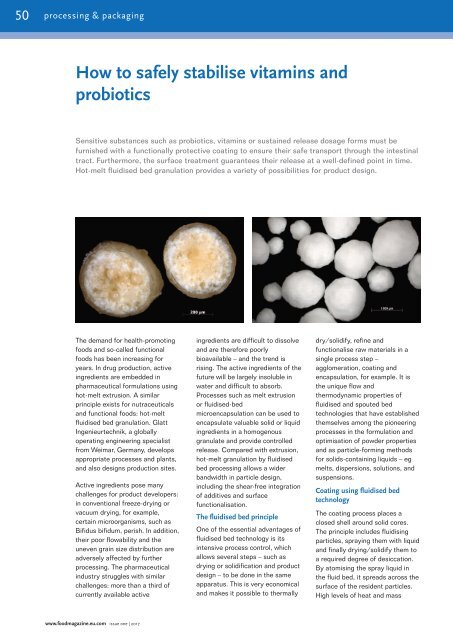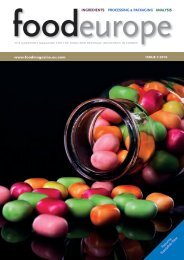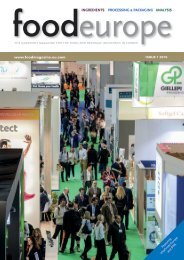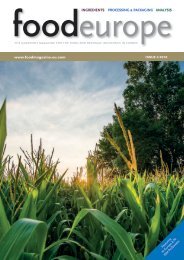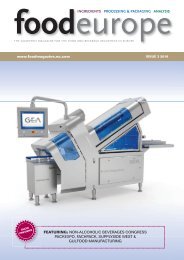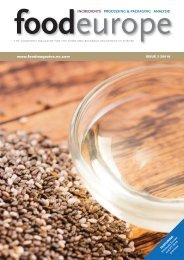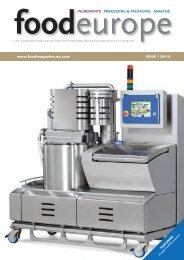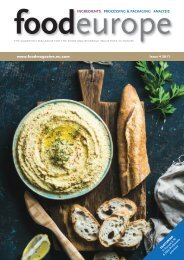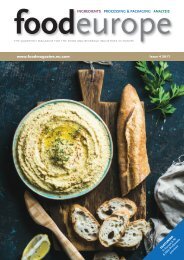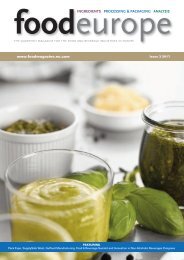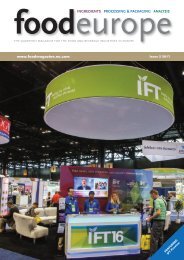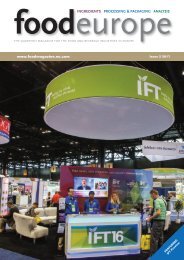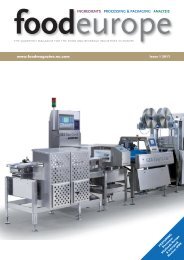issue 1 2017
Issue 1 2017 of FoodEurope Magazine
Issue 1 2017 of FoodEurope Magazine
You also want an ePaper? Increase the reach of your titles
YUMPU automatically turns print PDFs into web optimized ePapers that Google loves.
50<br />
processing & packaging<br />
How to safely stabilise vitamins and<br />
probiotics<br />
Sensitive substances such as probiotics, vitamins or sustained release dosage forms must be<br />
furnished with a functionally protective coating to ensure their safe transport through the intestinal<br />
tract. Furthermore, the surface treatment guarantees their release at a well-defined point in time.<br />
Hot-melt fluidised bed granulation provides a variety of possibilities for product design.<br />
The demand for health-promoting<br />
foods and so-called functional<br />
foods has been increasing for<br />
years. In drug production, active<br />
ingredients are embedded in<br />
pharmaceutical formulations using<br />
hot-melt extrusion. A similar<br />
principle exists for nutraceuticals<br />
and functional foods: hot-melt<br />
fluidised bed granulation. Glatt<br />
Ingenieurtechnik, a globally<br />
operating engineering specialist<br />
from Weimar, Germany, develops<br />
appropriate processes and plants,<br />
and also designs production sites.<br />
Active ingredients pose many<br />
challenges for product developers:<br />
in conventional freeze-drying or<br />
vacuum drying, for example,<br />
certain microorganisms, such as<br />
Bifidus bifidum, perish. In addition,<br />
their poor flowability and the<br />
uneven grain size distribution are<br />
adversely affected by further<br />
processing. The pharmaceutical<br />
industry struggles with similar<br />
challenges: more than a third of<br />
currently available active<br />
ingredients are difficult to dissolve<br />
and are therefore poorly<br />
bioavailable – and the trend is<br />
rising. The active ingredients of the<br />
future will be largely insoluble in<br />
water and difficult to absorb.<br />
Processes such as melt extrusion<br />
or fluidised-bed<br />
microencapsulation can be used to<br />
encapsulate valuable solid or liquid<br />
ingredients in a homogenous<br />
granulate and provide controlled<br />
release. Compared with extrusion,<br />
hot-melt granulation by fluidised<br />
bed processing allows a wider<br />
bandwidth in particle design,<br />
including the shear-free integration<br />
of additives and surface<br />
functionalisation.<br />
The fluidised bed principle<br />
One of the essential advantages of<br />
fluidised bed technology is its<br />
intensive process control, which<br />
allows several steps – such as<br />
drying or solidification and product<br />
design – to be done in the same<br />
apparatus. This is very economical<br />
and makes it possible to thermally<br />
dry/solidify, refine and<br />
functionalise raw materials in a<br />
single process step –<br />
agglomeration, coating and<br />
encapsulation, for example. It is<br />
the unique flow and<br />
thermodynamic properties of<br />
fluidised and spouted bed<br />
technologies that have established<br />
themselves among the pioneering<br />
processes in the formulation and<br />
optimisation of powder properties<br />
and as particle-forming methods<br />
for solids-containing liquids – eg<br />
melts, dispersions, solutions, and<br />
suspensions.<br />
Coating using fluidised bed<br />
technology<br />
The coating process places a<br />
closed shell around solid cores.<br />
The principle includes fluidising<br />
particles, spraying them with liquid<br />
and finally drying/solidify them to<br />
a required degree of desiccation.<br />
By atomising the spray liquid in<br />
the fluid bed, it spreads across the<br />
surface of the resident particles.<br />
High levels of heat and mass<br />
www.foodmagazine.eu.com <strong>issue</strong> one | <strong>2017</strong>


